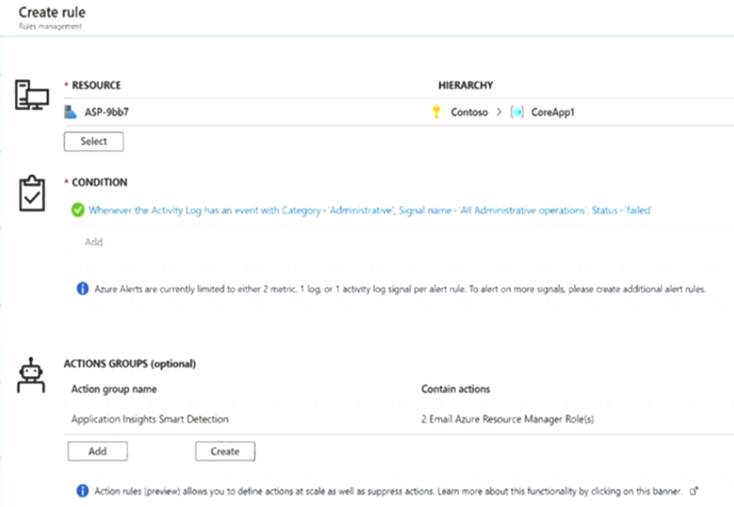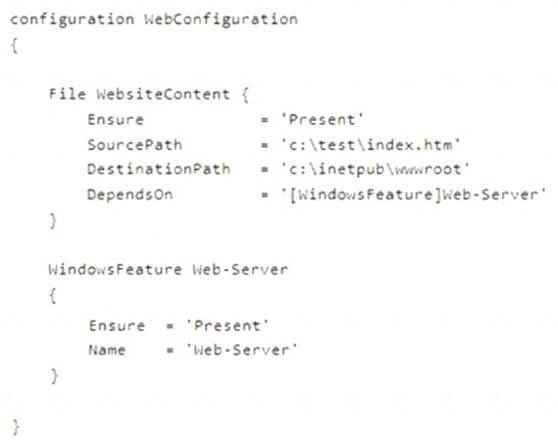- (Topic 4)
Note: This question is part of a series of questions that present the same scenario. Each question in the series contains a unique solution that might meet the stated goals Some question sets might have more than one correct solution, while others might not have a correct solution.
After you answer a question in this section, you will NOT be able to return to it. As a result, these questions will not appear in the review screen.
You have an approval process that contains a condition. The condition requires that releases be approved by a team leader before they are deployed.
You haw a pokey stating that approvals must occur within eight hours.
You discover that deployments only if the approvals take longer than two hours.
You need to ensure that the deployments only fail if the approvals take longer than hours. Solution From Post -deployment conditions, you modify the Timeout setting for post-
deployment approvals. Does this meet the goal?
Correct Answer:
B
HOTSPOT - (Topic 4)
You are designing YAML-based Azure pipelines for the apps shown in the following table.
You need to configure the YAML strategy value for each app. The solution must minimize app downtime.
Which value should you configure for each app? To answer, select the appropriate options in the answer area.
NOTE: Each correct selection is worth one point.
Solution:
App1: rolling
A rolling deployment replaces instances of the previous version of an application with instances of the new version of the application on a fixed set of virtual machines (rolling set) in each iteration.
App2: canary
Canary deployment strategy is an advanced deployment strategy that helps mitigate the risk involved in rolling out new versions of applications. By using this strategy, you can roll out the changes to a small subset of servers first. As you gain more confidence in the new version, you can release it to more servers in your infrastructure and route more traffic to it.
Does this meet the goal?
Correct Answer:
A
- (Topic 4)
Note: This question is part of a series of questions that present the same scenario. Each question in the series contains a unique solution that might meet the stated goals. Some question sets might have more than one correct solution, while others might not have a correct solution.
After you answer a question in this section, you will NOT be able to return to it. As a result, these questions will not appear in the review screen.
You plan to update the Azure DevOps strategy of your company.
You need to identify the following issues as they occur during the company’s development
process:
✑ Licensing violations
✑ Prohibited libraries
Solution: You implement automated security testing.
Does this meet the goal?
Correct Answer:
B
Instead use implement continuous integration.
Note: WhiteSource is the leader in continuous open source software security and compliance management. WhiteSource integrates into your build process, irrespective of your programming languages, build tools, or development environments. It works automatically, continuously, and silently in the background, checking the security, licensing, and quality of your open source components against WhiteSource constantly-updated denitive database of open source repositories.
Reference: https://azuredevopslabs.com/labs/vstsextend/whitesource/
- (Topic 4)
You have an Azure subscription that contains the resources shown in the following table.
DepPipeline1 and ADFPipeline1 use a single credential that is stored in Vault'. You need to configure ADFPipeline1 to retrieve the credential from Vault1. Which type of activity should you use?
Correct Answer:
A
- (Topic 4)
You have a GitHub repository.
You create a new repository in Azure DevOps.
You need to recommend a procedure to clone the repository from GitHub to Azure DevOps.
What should you recommend?
Correct Answer:
D
You can import an existing Git repo from GitHub, Bitbucket, GitLab, or other location into a new or empty existing repo in your project in Azure DevOps.
Import into a new repo
✑ Select Repos, Files.
✑ From the repo drop-down, select Import repository.
✑ If the source repo is publicly available, just enter the clone URL of the source repository and a name for your new Git repository.
References:
https://docs.microsoft.com/en-us/azure/devops/repos/git/import-git-repository?view=azure- devops